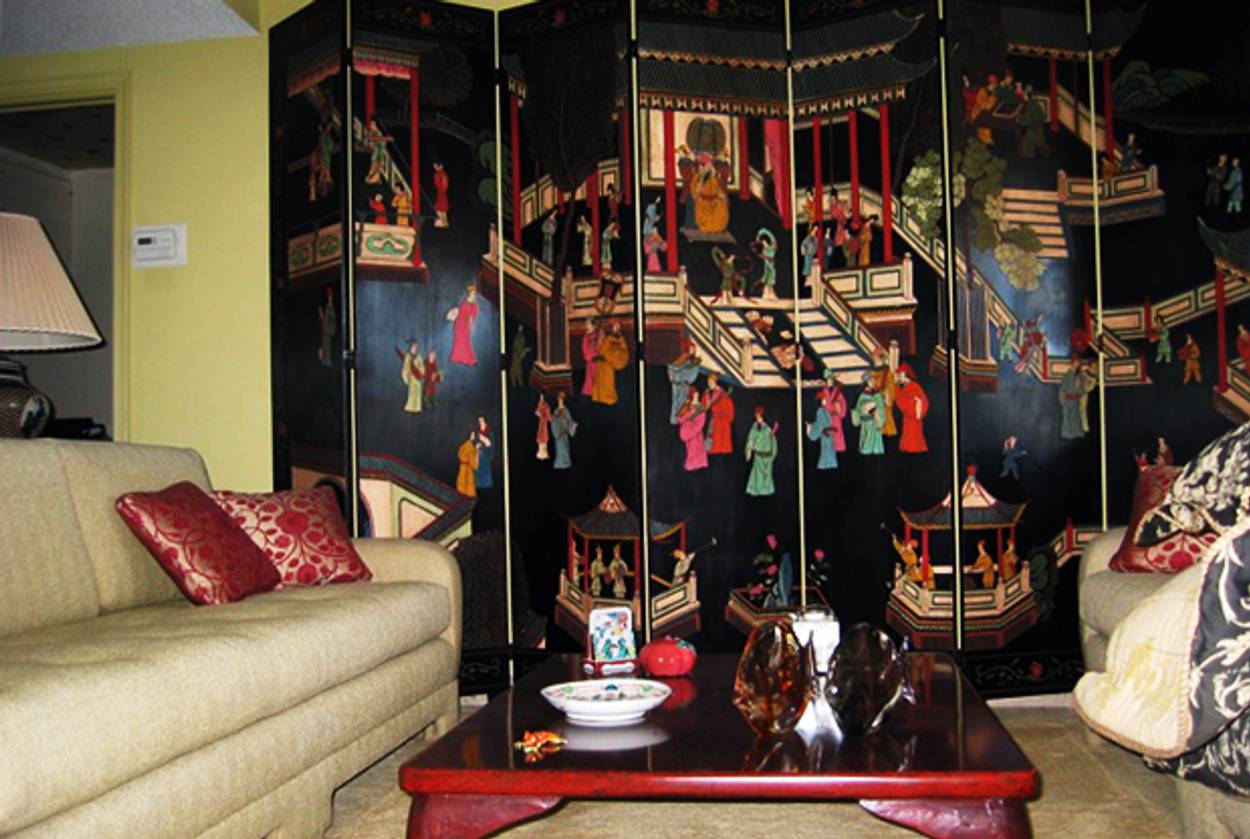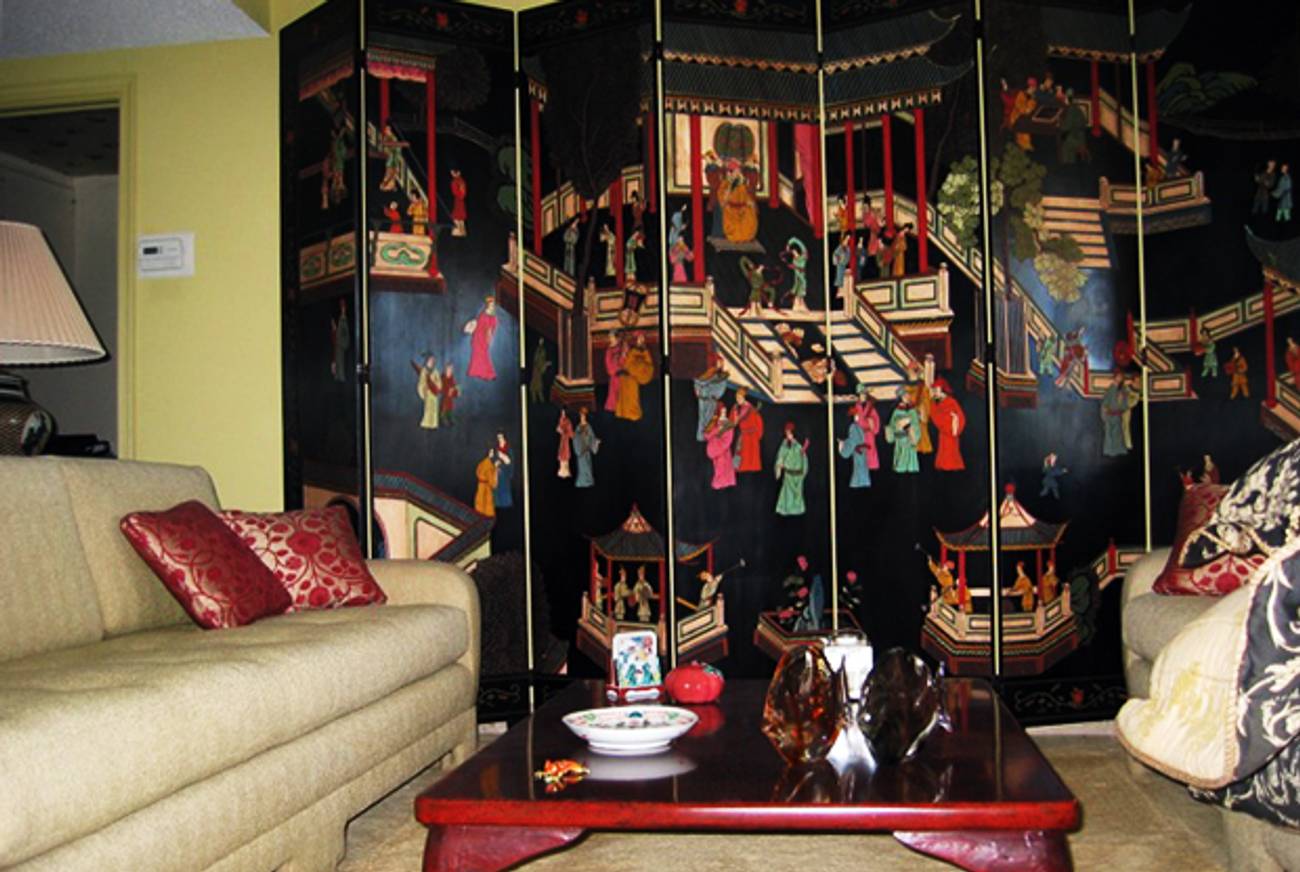China Patterns
Lacquer screens, silk pillows, even statues of Buddha—when it comes to decorating their homes, why do so many Jews look to Asia for inspiration?




You know the look. Maybe it’s your bubbe’s apartment in Boca or your elderly mother’s in Boynton Beach. Maybe it’s your great-aunt’s place in West Bloomfield or your cousins’ in Ridgewood. Wherever it is, it has beige wall-to-wall carpet, a nubbly-textured gold mid-century sofa, and more Asian art than you can shake a Shabbes candlestick at. Lacquer screens! Red latticework! Chinese painted vases! Fat Japanese men etched on glass!
A friend of mine in California recently posted pictures online of her mother’s gorgeous apartment in Palm Beach. I did a double take. It was a dead ringer for my grandmother’s apartment in Hallandale. It had the art with the pagodas on it; the shiny pillows with the delicate swirling embroidery; the chest inlaid with mother-of-pearl and dotted with willow trees, egrets, and richly robed ladies. Déjà vu den?
I asked the Jews of Facebook: Did your grandparents (or parents, for those d’un certain age) decorate their home with Orientalist Flair? Was there a certain Chinoiserie-fetish-y thing going on? Did the old Jews in your life favor Ambiguous Asian Style?
The outpouring: Absolutely. Stone warrior statues, Buddha heads, ceramic ginger-jar-style table lamps with raised cherry-blossom-sprigged bases, varnished and enameled tea trays. All there.
Illustrious and fabulous Jews who are not my friends’ parents enjoy this look as well. The theater impresario Charles Busch, whose home was featured in the Real Estate section of the New York Times, said of his living room, “I think it looks like a Chinese sanitarium.” Busch created the opium-addled character Lady Sylvia in the play Shanghai Moon (and played her in two off-Broadway productions), a character who swans, “I’m simply mad for Orientalia!” Indeed, aren’t we all?
But why? I emailed one of my go-to Jewish cultural whizzes, Jenna Weismann Joselit, director of the Program in Judaic Studies at George Washington University and Tablet contributor. She wrote back, “Ambiguous Asian decor seems to me to be of a piece with middle-class American Jewry’s affinity with mah jongg and Chinese food—very much an external marker of cosmopolitanism and sophistication.”
In seeking that kind of cosmopolitanism, the Jews really had no choice but to glom onto someone else’s artistic history. It’s not as if our forebears could trot out their own cultural bona fides in their décor. Their parents came to America, for the most part, with very little: a samovar, a kiddush cup, maybe candlesticks. Immigrant Jews don’t have Aubusson rugs or antique trestle tables. And wealthy Jews who fled the Nazis, like my husband’s family, tended to lose almost everything on the way over.
But as the horrors of the past recede, and people acculturate to a new place, they don’t want to be objects of pity.
We want to be stylish.
We want to show that we have disposable income and taste. And we’ve always had a little bit of a thing for the Chinese.
There are many possible reasons. The designer Jeffry Weisman of Fisher Weisman, whose work has been described by the New York Times Magazine as “drop dead, big city chic,” and whose interiors, furniture, and textiles have been featured in Elle Décor, Vogue, House & Garden, and House Beautiful, theorizes: “Jews as ethnic Americans connect more naturally to people, foods, and styles of adjacent ethnic cultures than they do with more traditional (read: bland) American foods and styles. Being in so many ways outsiders, we just have more in common.”
He points out that Asian décor is diverse enough to suit a variety of tastes. “For the modernists, the lovers of the legacy of the Bauhaus, there are endless examples of elegant simplicity crafted from simple materials. A Japanese tansu chest or Chinese bamboo console can be the perfect pivot for a room full of more generic modern furnishings. And for the crowd drawn to drama and glamour [read: Charles Busch—Ed.] the profusion of carved and lacquered furnishings of Japan and to a greater extent China are highly seductive purely for their decorative value.” Weisman further posits that Jews may appreciate that Asian antiques have an illustrious pedigree. “There is a general nod to highly venerated European taste, which has incorporated fine Asian antiques for centuries in all the best palaces and grand houses. So to follow suit is to be connected to that sophisticated and worldly tradition,” he says. I’d add that the fact that Asian-y things are Other, yet are appreciated by history’s fancy-pants tastemakers, may be extra-appealing to Jews, who also see themselves as outsiders and long to be in.
The Chinese, in particular, are our brothers from another mother. As Marc Tracy pointed out in his Tablet piece on Jews and Chinese food last year, newly acculturating Jews found Chinese food just foreign and exotic enough. Unlike Italian restaurants, Chinese restaurants don’t have off-putting bleeding-saint and Holy-Virgin-adorned décor. The flavor profiles of Cantonese food are reassuringly Jew-y: sweet-and-sour, lots of garlic, no mixing of meat and dairy. Matthew Goodman, author of Jewish Food: The World at Table, told Tracy that Chinese restaurateurs quickly learned to capitalize on this affinity, advertising wonton soup as “chicken soup with kreplach.”
And maybe World War II had a role in broadening Jews’ global perspective. My brilliant friend Sara, who majored in History and Literature at Harvard and therefore knows these things, has another idea. “My theory is that the taste trend was influenced by returning Pacific-theater vets,” she says. Could be.
But maybe loving Asian stuff is a way to dissociate from the shtetl shame we feel in our own. David Mamet certainly thinks so. In “The Decoration of Jewish Houses,” an essay in his 1989 collection Some Freaks, Mamet bemoaned American Jews’ lack of pride as expressed in Jewish décor objects. “[I]n our homes, in that which speaks of rest, of identity, we have no symbols,” he wrote. “We do not know how a Jewish home (finally, we do not know how a Jew) is supposed to look. We see in our homes the occasional and vaguely Semitic ‘quote,’ a Hebraised motto in English, a mosaic coffee table, a piece of Judaica.” Mamet sees this lack of stuff as showing a desperate kind of assimilationism. “In our support of the moral, social, and emotional rights of the oppressed, we put ourselves, the Jews, behind not only every other racial group, we put ourselves behind the seals and the whales. Now, funny as that is, you, gentle reader, you tell me I’m wrong.”
Dave, you’re wrong. That may have been true in 1989 (and earlier—I’ve noted how the Jewish artist Ezra Jack Keats seemed to depict sympathetically children of every culture, race, and ethnicity except Judaism), but I don’t think it’s true now. Today’s Jews proudly display expansive walls of wedding and bar/bat mitzvah photos, kippot clearly visible. A lot of us do have Jewish ethnic art (bought with cash money, not inherited from grandparents) and modern Israeli art. My own favorite piece is a huge, battered wooden sign for a tailor shop on Lee Avenue in Williamsburg, Brooklyn, written in Yiddish. It looks like it’s from the turn of the century, but it’s actually a prop from the 1981 movie The Chosen, starring Robby Benson. The fake-realness and real-fakeness of it amuses me. Some of my other friends have Yiddish theater posters and pieces by contemporary Jewish-American artists. Yes, we Jews still love ethnic pieces that don’t reflect our own ethnicity (my last apartment looked like a Moroccan opium den) but I think that’s a reflection of globalization—a force for good and for ill—as much as the self-concept of American Jews.
Besides, maybe the Hebraic/Asian love affair goes both ways in this country. We’re the models for How to Make It in America. Our FOB (fresh off the boat) ancestors produced Ivy-educated doctor offspring. New immigrants look to us. My friend Jeff Yang, a columnist at the Wall Street Journal, deadpans, “Strangely, my parents decorated their house with Jewish bling.”
Marjorie Ingall is a columnist for Tablet Magazine, and author of Mamaleh Knows Best: What Jewish Mothers Do to Raise Successful, Creative, Empathetic, Independent Children.
Marjorie Ingall is a former columnist for Tablet, the author of Mamaleh Knows Best, and a frequent contributor to the New York Times Book Review.